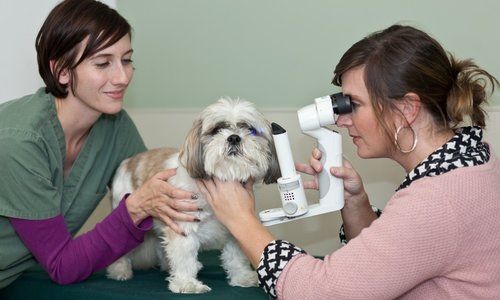Distichiasis in Dogs
Distichiasis may not be an everyday word to you but it is an eyelash disorder that, along with ectopic cilia and trichiasis, is quite common in our canine friends. This eyelash disorder can require special treatment so here is more about what it is, what causes it, what treatment methods are available, and how to care for your dog at home.
What is Distichiasis?
According to VCA Hospitals:
A distichia (plural distichiae) is an extra eyelash that arises from the margin of the eyelid through the duct or opening of the meibomian gland or adjacent to it, although they may arise at other locations along the eyelid margins. The condition in which these abnormal eyelashes are found is called distichiasis.
This isn’t an issue that is always a one-time thing. Instead, there may be multiple occurrences and each duct can have more than one – or many, for that matter. Even though dogs do not have bottom eyelashes, it can still present itself on the bottom lid.
In layman’s terms, this is a condition where the eyelash area of a dog has too many hairs. Basically, these hairs rub the eyeball of the dog and cause irritation. They can also lead to more serious conditions like corneal abrasions or corneal ulcers.
Why Does It Happen?
There isn’t a solid answer as to why some dogs get this condition and others do not. Sometimes the eyelashes simply show up in the meibomian glands, which are by the inner area of the eyelid. These glands are what produce tears or lubrication for the eyelid. One interesting thing is that it is seen in dogs like pugs and pekingeses where both breeds have bulging eyes prone to irritation.
It is recognized as a genetic issue though. This condition is typically inherited, as mentioned, but there are certain breeds where distichiasis is more common. These include:
- American Cocker Spaniel
- Boxer
- Miniature Poodles
- Pug
- Boston Terrier
- Cavalier King Charles Spaniel
- English Bulldogs
- Shih Tzu
- Pekingese
- Shetland Sheepdogs
- Lhasa Apso
- Miniature Long-haired Dachshunds
- Chesapeake Retriever
What Are the Symptoms?
The problem with distichiasis in dogs is that often there is not an outlying symptom that allows you to see that there is a problem. In other cases, there are outward symptoms to be aware of:
- Still eyelashes or cilia
- Corneal ulcers
- Inflammation
- Pain
- Eye discharges
- Dog may try to paw at their eyes but this is rare
- Iris pigmentation changes
- Blepharospasm, which is an abnormal eyelid twitch or tic
- Cornea has more blood vessels or an increased amount
- An overflow of tears known as epiphora
How is Distichiasis Diagnosed?
In order to make a diagnosis of distichiasis, the vet will look at the eyelashes that touch the conjunctival lining of the affected eye or the cornea, or are coming from the meibomian gland openings. Doing an examination that includes fluorescent corneal staining helps the vet evaluate if it is indeed distichiasis or another eye issue. They can also look at how much lubrication the dog’s eyes have to better help the diagnosis. This is called a Schirmer tear test.
Some dogs will require topical anesthetics or sedatives to relieve the intense discomfort and allow a thorough examination of the tissues surrounding the eye.
This condition can be found in any age of dog but it is usually found in younger dogs or those under three years old.
It is imperative to have your dog checked by a vet if they are showing any of the symptoms so that you can get a head start on mitigating any damages that the dog might incur to its eye. If left untreated, this condition may cause cornea scarring or ulceration, which leads to further issues such as blindness.
What is the Treatment?
There are quite a few treatment methods that your vet can recommend. The vet will tell you which one they think is best depending on the severity of the issue. Some treatments may sound good but are not recommended such as plucking the hairs or thermocautery and lid-splitting.
The treatment methods are:
- Cryosurgery. This freezes the extra hairs at the lid margin.
- Surgery. This removes the hairs around the eyelids permanently.
- Electrolysis. This also permanently removes the hair around the lid margin.
While these methods work well to fix the issue, there is no guarantee that there won’t be regrowth of the hair follicle – even after being removed permanently. This is why it is important to see the veterinarian for follow-up visits. The vet can check to see if there is any regrowth and see how the dog is progressing with his healing.
With surgical options and follow-up visits, it can get expensive. This is why pet insurance is a good idea so that you won’t have to pay so much out of your own pocket. It gives you peace of mind that you have more freedom to treat your dog’s issues accordingly.
At-Home Care
As mentioned at Veterinary Partner:
Once the hairs have been removed permanently, the prognosis is good. However, dogs with distichiasis should not be used for breeding, because of the hereditary aspects.
Simply keep an eye on your dog’s eyes after treatment and be sure to see the vet for follow-ups. If you see anything abnormal in the meantime, call your vet and let them know what is going on so they can advise you of what to do.
Related Content



















